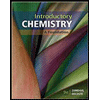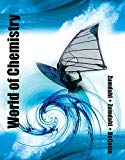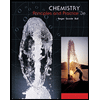
Mastering Chemistry with Pearson eText -- Standalone Access Card -- for Introductory Chemistry (6th Edition)
6th Edition
ISBN: 9780134565927
Author: Nivaldo J. Tro
Publisher: PEARSON
expand_more
expand_more
format_list_bulleted
Concept explainers
Question
Chapter 17, Problem 62E
Interpretation Introduction
Interpretation:
For each of the given nuclide,
Concept introduction:
Beta radiation is a consequence of emission of an electron from an unstable nucleus.
The symbol of beta particle is denoted as e0−1.
The beta radiation can be represented by the nuclear reaction as follows:
R22888a⎵parent nuclide→T22889h+e0−1⎵Daughter nuclides
The
Expert Solution & Answer
Want to see the full answer?
Check out a sample textbook solution
Students have asked these similar questions
Writing the rate law implied by a simple mechanism
To exit full screen, press and hold esc
Suppose the decomposition of dinitrogen monoxide proceeds by the following mechanism:
elementary reaction
step
rate constant
1
→
N2O(g) N2(g) + O(g)
k₁
→>>
N2(g) + O2(g)
k2
2 N2O(g) + O(g)
Suppose also k₁ «k2. That is, the first step is much slower than the second.
Write the balanced
chemical equation for the
overall chemical reaction:
Write the experimentally-
observable rate law for the
overall chemical reaction.
☐
rate
= k
Note: your answer should
not contain the
concentrations of any
intermediates.
Express the rate constant
k for the overall chemical
reaction in terms of K1, K2,
and (if necessary) the rate
constants k-1 and K-2 for
the reverse of the two
elementary reactions in
the mechanism.
k = |
Х
?
000
18
Ar
Using first- and second-order integrated rate laws
Consider this reaction:
CICH2CH2Cl (g) → CH2CHC1 (g) + HCl (g)
-
At a certain temperature it obeys this rate law.
S
rate = (0.0413 s¯¹) [CICH₂CH₂CI]
Suppose a vessel contains CICH2CH2Cl at a concentration of 0.150M. Calculate the concentration of CICH2CH2Cl in the vessel 39.0 seconds later. You may
assume no other reaction is important.
Round your answer to 2 significant digits.
Ом
x10
☑
?
00.
18
Ar
。
Hello I need homework help. Please focus on box 2 and 3, box 1 is correct.
Chapter 17 Solutions
Mastering Chemistry with Pearson eText -- Standalone Access Card -- for Introductory Chemistry (6th Edition)
Ch. 17 - Prob. 1SAQCh. 17 - Prob. 2SAQCh. 17 - Prob. 3SAQCh. 17 - Prob. 4SAQCh. 17 - Prob. 5SAQCh. 17 - Prob. 6SAQCh. 17 - Prob. 7SAQCh. 17 - Prob. 8SAQCh. 17 - Prob. 9SAQCh. 17 - Prob. 10SAQ
Ch. 17 - Prob. 1ECh. 17 - Prob. 2ECh. 17 - Prob. 3ECh. 17 - Prob. 4ECh. 17 - Prob. 5ECh. 17 - Prob. 6ECh. 17 - Prob. 7ECh. 17 - Prob. 8ECh. 17 - Prob. 9ECh. 17 - Prob. 10ECh. 17 - Prob. 11ECh. 17 - Prob. 12ECh. 17 - Prob. 13ECh. 17 - Prob. 14ECh. 17 - Prob. 15ECh. 17 - Prob. 16ECh. 17 - Prob. 17ECh. 17 - Prob. 18ECh. 17 - Prob. 19ECh. 17 - Prob. 20ECh. 17 - Prob. 21ECh. 17 - Prob. 22ECh. 17 - Prob. 23ECh. 17 - Prob. 24ECh. 17 - Prob. 25ECh. 17 - Prob. 26ECh. 17 - Prob. 27ECh. 17 - Prob. 28ECh. 17 - Prob. 29ECh. 17 - Prob. 30ECh. 17 - Prob. 31ECh. 17 - Prob. 32ECh. 17 - Prob. 33ECh. 17 - Prob. 34ECh. 17 - Prob. 35ECh. 17 - Prob. 36ECh. 17 - Prob. 37ECh. 17 - Prob. 38ECh. 17 - Prob. 39ECh. 17 - Prob. 40ECh. 17 - Prob. 41ECh. 17 - Prob. 42ECh. 17 - Prob. 43ECh. 17 - Prob. 44ECh. 17 - Prob. 45ECh. 17 - Prob. 46ECh. 17 - Prob. 47ECh. 17 - Prob. 48ECh. 17 - Prob. 49ECh. 17 - Prob. 50ECh. 17 - Draw the symbol for the isotope of lead that...Ch. 17 - Prob. 52ECh. 17 - Prob. 53ECh. 17 - Prob. 54ECh. 17 - Prob. 55ECh. 17 - Prob. 56ECh. 17 - Prob. 57ECh. 17 - Prob. 58ECh. 17 - Prob. 59ECh. 17 - Prob. 60ECh. 17 - Prob. 61ECh. 17 - Prob. 62ECh. 17 - Prob. 63ECh. 17 - Prob. 64ECh. 17 - Prob. 65ECh. 17 - Prob. 66ECh. 17 - Prob. 67ECh. 17 - Prob. 68ECh. 17 - Prob. 69ECh. 17 - Prob. 70ECh. 17 - Prob. 71ECh. 17 - Prob. 72ECh. 17 - Prob. 73ECh. 17 - Prob. 74ECh. 17 - Prob. 75ECh. 17 - Prob. 76ECh. 17 - Prob. 77ECh. 17 - Prob. 78ECh. 17 - Prob. 79ECh. 17 - Prob. 80ECh. 17 - Prob. 81ECh. 17 - Prob. 82ECh. 17 - Prob. 83ECh. 17 - Prob. 84ECh. 17 - Prob. 85ECh. 17 - Prob. 86ECh. 17 - Prob. 87ECh. 17 - Prob. 88ECh. 17 - Prob. 89ECh. 17 - Prob. 90ECh. 17 - Prob. 91ECh. 17 - 92. The fusion of deuterium and tritium produces J...Ch. 17 - Prob. 93ECh. 17 - Prob. 94ECh. 17 - Prob. 95ECh. 17 - Prob. 96ECh. 17 - Prob. 97ECh. 17 - Prob. 98ECh. 17 - Prob. 99ECh. 17 - Prob. 100ECh. 17 - Prob. 101ECh. 17 - Prob. 102ECh. 17 - Prob. 103QGWCh. 17 - Prob. 104QGWCh. 17 - Prob. 105QGWCh. 17 - Prob. 106QGWCh. 17 - Prob. 107DIA
Knowledge Booster
Learn more about
Need a deep-dive on the concept behind this application? Look no further. Learn more about this topic, chemistry and related others by exploring similar questions and additional content below.Similar questions
- Using first- and second-order integrated rate laws At a certain temperature the rate of this reaction is second order in H3PO4 with a rate constant of 0.709M¯¯ 2H3PO4 (aq) → P₂O5(aq)+3H₂O(aq) -1 -1 ·S Round your answer to 2 significant digits. Suppose a vessel contains H3PO4 at a concentration of 0.880M. Calculate how long it takes for the concentration of H3PO4 to decrease to 0.141M. You may assume no other reaction is important. x10 ? 00. 18 무arrow_forwardNaming coordination compounds Name these coordination compounds. formula [FeCl2 (CO)4] Cl Na₂ [MnBr, (NH)₂] 4 [GCL (H,0),]C name Х 000 18 Ararrow_forwardWhy does this phenomenon of optically active occur? As you observed in the lab, why do the various compounds alter the results? What causes the differences? How do you know these molecules are all optically active, if they are? How does the concentration, purity, and identity of the substance effect the results? What must occur for the phenomenon to be observed?arrow_forward
- Deducing a rate law from the change in concentration over time A chemistry graduate student is studying the rate of this reaction: 2NH3 (g) → N2 (g) +3H₂ (g) She fills a reaction vessel with NH3 and measures its concentration as the reaction proceeds: ? time (minutes) [NH3] 0 1.00M 1.0 0.571M 2.0 0.400 M 3.0 0.307M 4.0 0.250M Use this data to answer the following questions. Write the rate law for this reaction. rate k ☐ x10 Calculate the value of the rate constant k. k = ☐ Round your answer to 2 significant digits. Also be sure your answer has the correct unit symbol. G 000 18 Ar 。arrow_forwardWriting the rate law implied by a simple mechanism Suppose the formation of dinitrogen pentoxide proceeds by the following mechanism: step elementary reaction - 1 NO2(g) + O2(g) → NO(g) + O2(g) 2 NO3(g) + NO2(g) → N₂O(g) rate constant k₁ k₂ Suppose also k₁ «k2. That is, the first step is much slower than the second. Write the balanced chemical equation for the overall chemical reaction: Write the experimentally- observable rate law for the overall chemical reaction. Note: your answer should not contain the concentrations of any intermediates. ☐ rate = ☐ Express the rate constant k for the overall chemical reaction in terms of K1, K2, and (if necessary) the rate constants k-1 and K-2 for the reverse of the two elementary reactions in the mechanism. k = ☐ Х 5 olo 18 Ararrow_forwardpls help asap on all.arrow_forward
- pls help asap on all.arrow_forwardpls help asap on all.arrow_forward18. A 10.2g piece of coal (carbon) is combusted completely beneath a calorimeter containing 800.0 mL of water. The initial temp of the water was 20.0°C, and the final temp was 62.7°C. Assuming complete transfer of heat from the carbon to the water, what is the molar enthalpy of combustion of carbon?arrow_forward
- pls help asap on all.arrow_forwardpls help asap on all.arrow_forwardUse the reaction coordinate graph below to answer questions 13-15: 13. Which step is the rate determining step? a. C→ E b. E→ G C. A → C d. Not enough information 14. The overall reaction: a. is exothermic b. is endothermic C. has no change in energy Energy d. not enough information 15. The activation energy for the overall reaction would be equal to: a. Ꭰ A b. F C. B d. B + D + F B 0 D E Reaction coordinate Garrow_forward
arrow_back_ios
SEE MORE QUESTIONS
arrow_forward_ios
Recommended textbooks for you
 Introductory Chemistry: A FoundationChemistryISBN:9781337399425Author:Steven S. Zumdahl, Donald J. DeCostePublisher:Cengage Learning
Introductory Chemistry: A FoundationChemistryISBN:9781337399425Author:Steven S. Zumdahl, Donald J. DeCostePublisher:Cengage Learning World of Chemistry, 3rd editionChemistryISBN:9781133109655Author:Steven S. Zumdahl, Susan L. Zumdahl, Donald J. DeCostePublisher:Brooks / Cole / Cengage Learning
World of Chemistry, 3rd editionChemistryISBN:9781133109655Author:Steven S. Zumdahl, Susan L. Zumdahl, Donald J. DeCostePublisher:Brooks / Cole / Cengage Learning General, Organic, and Biological ChemistryChemistryISBN:9781285853918Author:H. Stephen StokerPublisher:Cengage Learning
General, Organic, and Biological ChemistryChemistryISBN:9781285853918Author:H. Stephen StokerPublisher:Cengage Learning Chemistry: Principles and PracticeChemistryISBN:9780534420123Author:Daniel L. Reger, Scott R. Goode, David W. Ball, Edward MercerPublisher:Cengage LearningChemistry: Matter and ChangeChemistryISBN:9780078746376Author:Dinah Zike, Laurel Dingrando, Nicholas Hainen, Cheryl WistromPublisher:Glencoe/McGraw-Hill School Pub Co
Chemistry: Principles and PracticeChemistryISBN:9780534420123Author:Daniel L. Reger, Scott R. Goode, David W. Ball, Edward MercerPublisher:Cengage LearningChemistry: Matter and ChangeChemistryISBN:9780078746376Author:Dinah Zike, Laurel Dingrando, Nicholas Hainen, Cheryl WistromPublisher:Glencoe/McGraw-Hill School Pub Co Living By Chemistry: First Edition TextbookChemistryISBN:9781559539418Author:Angelica StacyPublisher:MAC HIGHER
Living By Chemistry: First Edition TextbookChemistryISBN:9781559539418Author:Angelica StacyPublisher:MAC HIGHER

Introductory Chemistry: A Foundation
Chemistry
ISBN:9781337399425
Author:Steven S. Zumdahl, Donald J. DeCoste
Publisher:Cengage Learning

World of Chemistry, 3rd edition
Chemistry
ISBN:9781133109655
Author:Steven S. Zumdahl, Susan L. Zumdahl, Donald J. DeCoste
Publisher:Brooks / Cole / Cengage Learning

General, Organic, and Biological Chemistry
Chemistry
ISBN:9781285853918
Author:H. Stephen Stoker
Publisher:Cengage Learning

Chemistry: Principles and Practice
Chemistry
ISBN:9780534420123
Author:Daniel L. Reger, Scott R. Goode, David W. Ball, Edward Mercer
Publisher:Cengage Learning

Chemistry: Matter and Change
Chemistry
ISBN:9780078746376
Author:Dinah Zike, Laurel Dingrando, Nicholas Hainen, Cheryl Wistrom
Publisher:Glencoe/McGraw-Hill School Pub Co

Living By Chemistry: First Edition Textbook
Chemistry
ISBN:9781559539418
Author:Angelica Stacy
Publisher:MAC HIGHER